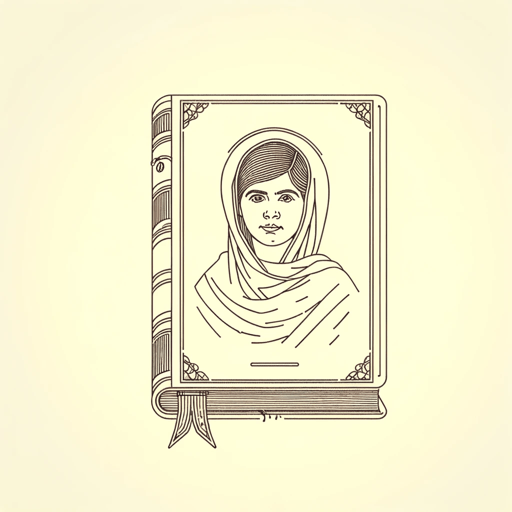87 pages • 2 hours read
Malala YousafzaiWe Are Displaced
Nonfiction | Autobiography / Memoir | YA | Published in 2018A modern alternative to SparkNotes and CliffsNotes, SuperSummary offers high-quality Study Guides with detailed chapter summaries and analysis of major themes, characters, and more. For select classroom titles, we also provide Teaching Guides with discussion and quiz questions to prompt student engagement.
Summary and Study Guide
Overview
We Are Displaced is a 2019 book written by Malala Yousafzai with 11 contributors. In We Are Displaced, Yousafzai reflects on her personal journey as a displaced person while also sharing testimonials from other young women who have also experienced displacement. Yousafzai became famous in 2012 after surviving an assassination attempt by the Taliban in her home city of Mingora, Pakistan. After recovering from her injuries, she became an activist for girls’ education around the world and was awarded the Nobel Peace Prize for her work in 2014. The contributors featured in this work are women who come from countries such as Yemen, Iraq, Myanmar, and Congo, who were displaced from their homes when local conflicts threatened their safety. This SuperSummary study guide is based on the Kindle Edition of this book; please note that all citations in this study guide refer to location not page. Readers should be aware that the testimonials in this book have distressing themes that include descriptions of violence.
Summary
In her first two chapters, Yousafzai recounts how the growing influence of the Taliban affected her early childhood in Swat Valley, Pakistan. Like many Pakistanis, her parents were always staunchly opposed to the Taliban’s theology and policies, which differed greatly from their own faith and lifestyle. She recalls how her father, Ziauddin Yousafzai, ran two local schools and was deeply upset when he had to close his school for girls, which Malala also attended. Yousafzai describes how the Taliban’s terrorism against civilians in her region became increasingly frequent and hostile, until the Pakistani government required all civilians to evacuate the Swat Valley within two days so they could launch an offensive against the Taliban.
In Chapters 3-4, Yousafzai recounts her family’s experience of evacuating from Mingora to Shangla, where they were internally displaced for three months and lived off the kindness of relatives. The author describes the difficult journey the Swat Valley’s residents had to make as they left their homes, often traveling on foot with young and elderly family members and few resources. During this time Yousafzai and her father spoke out publicly against the Taliban’s insurgency, and against their policy of denying girls access to education. Malala contributed to BBC Urdu as a blogger, sharing her experience and opinions with other Pakistani readers.
Yousafzai recalls her family’s experience of returning home after their internal displacement in Chapter 5. She remembers feeling both shocked at the extent of the destruction her home city Mingora suffered, as well as relieved that her home was still standing. Hopeful that life would return to normal, Yousafzai resumed her studies. The Taliban retained a presence in the Swat Valley, and though their influence had diminished, they continued to attack people who spoke out against them. One day in 2012, a Taliban gunman attempted to assassinate Yousafzai, who they targeted because of her girls’ rights activism.
Chapter 6 explores how Yousafzai she came to live in England, where she recovered from her injuries and returned to school. She explains that while her abrupt displacement from Pakistan led to feelings of homesickness, she was also grateful to be able to continue her studies and live in safety. Yousafzai shares her determination to not be silenced by her traumatic experience, but instead to take advantage of the fame it gave her and to continue her activism on a greater scale.
Yousafzai begins Part 2 of We Are Displaced by explaining how she came to meet different displaced women through her activism. Yousafzai personally selected the contributors to share their testimonials after meeting them at refugee camps, film screenings, and other events. The first author, Zaynab, is a Yemeni woman who escaped the civil war there to live in Egypt with extended family. She had the good fortune of receiving a visa to America, but explains that this experience was difficult, as it required her to leave her younger sister Sabreen behind. The next author is Sabreen herself, who shares her story of deciding to pay a smuggler to cross the Mediterranean by boat to Italy. She vividly describes her dangerous voyage with hundreds of other refugees, and her luck at being rescued by the Italian Coast Guard.
In the following chapter, Muzoon, a refugee from Syria, describes her family’s experience of fleeing the civil war in Syria to live in a refugee camp in Jordan. Like Malala Yousafzai, she was determined to stay in school despite her displacement and did her best to persuade other refugee girls to attend the camp’s learning center as well.
Najla, a Yazidi woman from Iraq, shares in her testimonial that growing up in a conservative family meant that she always had to beg to go to school, something that her father was very ambivalent to allow. Najla also recalls her family’s harrowing ordeal of escaping the ISIS massacre in their hometown and fleeing to Dohuk, Iraq. She explains that despite her displacement, she hopes to attend college, and that Malala is a source of inspiration to her.
The book’s next contributor is Maria, whose family fled their farm in Columbia due to organized violence and lived in a series of refugee camps and modest homes for years afterward. Maria explains that they remain displaced because guerilla forces continue to occupy her region.
The following chapter showcases a different challenge, as Analisa did not flee violent conflict, but instead sought to escape a troubled family life in Guatemala and start afresh in the US. Analisa recounts how her parents’ deaths prompted her to live with her half-brother, who insulted her and controlled her finances. This tension caused her to seek out common immigrant routes to the US, paying smugglers and guides to help her. Despite being caught by US police and being incarcerated in their facilities, Analisa was released to live with her other brother, Ernesto, and credits her Adventist faith for keeping her strong.
Marie Claire, a refugee from the Congo, then shares her story of fleeing violence in her home country as well as in Zambia. Marie Claire was particularly dedicated to her studies and describes how her mother passionately supported her education before she was murdered. Marie Claire and her extended family were granted visas to the US, where a volunteer named Jennifer helped them adjust to their new home in Pennsylvania. In the following chapter, Jennifer recounts meeting Marie Claire and her family and feeling inspired by Marie Claire’s determination to finish her high school education in the US despite the culture shock and language barrier.
Next Ajida, a Rohingya woman from Myanmar, shares her testimonial about fleeing from her nation’s military and police attacks against her community. She shares how she and her family survived days of travel in the jungle to escape Myanmar and join thousands of other Rohingya in a refugee camp in neighboring Bangladesh. Ajida is the only refugee among the contributors who is also a parent, and her chapter demonstrates the challenge of being displaced while raising young children.
In the book’s final testimonial, Farah revisits her family’s native Uganda and reflects on her journey which began as a displaced toddler fleeing Idi Amin’s regime in the 1970s. Farah shares her experience of growing up in Canada and her desire to reconnect with her Ugandan roots as an adult.
Finally, Yousafzai pens the book’s Epilogue which recounts her first visit to her family home in Mingora since surviving the assassination attempt. The author reiterates the importance of understanding displaced people’s experiences and her personal dedication to improving girls’ rights and access to education.
Related Titles
By Malala Yousafzai
Featured Collections
Books that Feature the Theme of...
View Collection
Books that Teach Empathy
View Collection
Community
View Collection
Contemporary Books on Social Justice
View Collection
Education
View Collection
Family
View Collection
Fear
View Collection
Feminist Reads
View Collection
Grief
View Collection
Immigrants & Refugees
View Collection
Memory
View Collection
Middle Grade Nonfiction
View Collection
Politics & Government
View Collection
Required Reading Lists
View Collection
Safety & Danger
View Collection
War
View Collection



